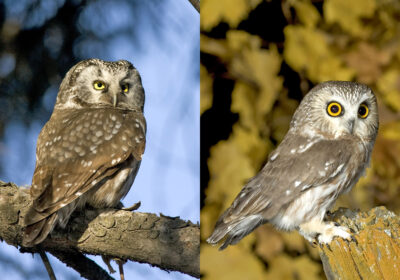
Owls come in all shapes and sizes. Here are some ways to tell two closely related smaller owls apart:
- CALL: This is the obvious first pass on these birds. If you are fortunate enough to hear them, Boreal Owls have a haunting call with bursts of several notes in successive groups. Northern Saw Whet Owls have a more monotone single note call.
- SHAPE: Both of these owls have oversized heads for their small bodies, and neither of them has ear tufts. Boreal Owls have somewhat square heads and Saw Whet Owls’ are more rounded. Both have feathered legs.
- COLOR: Both are brown with white spots or marks on their backs and streaked bellies. Boreal Owls have more grey on their faces and darker facial outline ring than Saw Whet owls whose facial disc is white.
- SIZE: Boreal Owls are slightly larger than Saw Whet Owls by 2-3 inches. As a comparison, Boreal Owls are smaller than Barred Owls, and Saw Whet than Screech Owls.
- WHERE ARE YOU AND WHEN? Although Boreal and Saw Whet Owls have some overlapping year-round ranges, Boreal Owls do not migrate and are found in the northern boreal forests in Alaska and Canada, only visiting the US along the Rockies. They are found around the globe in forests in northern polar regions. Saw Whet Owls, however, do migrate. They are found throughout much of the US, and outside of breeding season as far south as North Carolina and sometimes into Mexico. Where you are seeing the bird can make a difference.
Have a great time looking for owls!